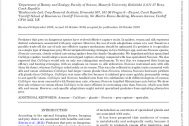Content
Predators that prey on dangerous species have evolved effective capture traits. In spiders, venom and silk represent distinct substances associated with prey capture. However, the use of such adaptations comes at a cost. Based on a possible trade-off, the use of only one effective capture mechanism should be optimized if a predator is to specialize on a single type of dangerous prey. We investigated hunting strategies in two Callilepis spp. and one Nomisia species, Nomisia exornata, closely related ant-eating spiders from the family Gnaphosidae. We hypothesized that specialized Callilepis spiders would adopt a more stereotyped capture strategy compared with less specialized Nomisia. We also expected that Callilepis would rely on only one subjugation mechanism. To test this, we compared their hunting efficacy and hunting strategies, with an emphasis on venom vs. silk utilization. Nomisia restrained ants with silk (then bit them), whereas Callilepis relied solely on its venom. This was also reflected in trophic traits connected with silk and venom utilization
Callilepis had larger venom glands than Nomisia, whereas Nomisia had more piriform silk glands than Callilepis. Callilepis was more effective because it subdued prey more quickly, presumably owing to ant-specific venom. Callilepis and Nomisia handled ants from two subfamilies with different degrees of success
Callilepis was more successful with Formicinae ants, whereas Nomisia handled Myrmicinae ants better. We show
that sole reliance on venom allows Callilepis to be more efficient in overcoming ants than Nomisia, which uses both silk and venom. However, such specific adaptations might restrict specialized predators from exploiting alternative prey.
Callilepis had larger venom glands than Nomisia, whereas Nomisia had more piriform silk glands than Callilepis. Callilepis was more effective because it subdued prey more quickly, presumably owing to ant-specific venom. Callilepis and Nomisia handled ants from two subfamilies with different degrees of success
Callilepis was more successful with Formicinae ants, whereas Nomisia handled Myrmicinae ants better. We show
that sole reliance on venom allows Callilepis to be more efficient in overcoming ants than Nomisia, which uses both silk and venom. However, such specific adaptations might restrict specialized predators from exploiting alternative prey.



